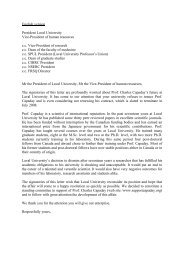Untitled - Laboratory of Neurophysics and Physiology
Untitled - Laboratory of Neurophysics and Physiology
Untitled - Laboratory of Neurophysics and Physiology
Create successful ePaper yourself
Turn your PDF publications into a flip-book with our unique Google optimized e-Paper software.
P297<br />
A numerical renormalisation group method for the analysis <strong>of</strong> critical spreading<br />
activity in spiking neural networks<br />
Thomas G Corcoran ⋆ , Andy Philippides, <strong>and</strong> Thomas Nowotny<br />
Centre for Computational Neuroscience <strong>and</strong> Robotics, University <strong>of</strong> Sussex, Falmer, BN1 9RH, UK<br />
P298<br />
Changes in V1 orientation tuning when blocking astrocytic glutamate transporters:<br />
Models for extra- <strong>and</strong> intrasynaptic mechanisms<br />
Konstantin Mergenthaler 1⋆ , Dipanjan Roy 1 , Jeremy Petravicz 2 , Mriganka Sur 2 , <strong>and</strong> Klaus<br />
Obermayer 1<br />
1 Neural Information Processing, School <strong>of</strong> Computer Science <strong>and</strong> Electrical Engineering <strong>and</strong> Bernstein<br />
Center for Computational Neurocience, Technische Universität Berlin, Germany<br />
2 Department <strong>of</strong> Brain <strong>and</strong> Cognitive Sciences, Piclower Institut for Learning <strong>and</strong> Memory, Massachusetts<br />
Institute <strong>of</strong> Technology, Cambridge, Massachusetts, USA<br />
P299<br />
How adaptation currents <strong>and</strong> synaptic inhibition change threshold, gain <strong>and</strong> variability<br />
<strong>of</strong> neuronal spiking<br />
Josef Ladenbauer 1,2⋆ , Moritz Augustin 1,2 , <strong>and</strong> Klaus Obermayer 1,2<br />
1 Neural Information Processing Group, Berlin Institute <strong>of</strong> Technology, Berlin, Germany<br />
2 Bernstein Center for Computational Neuroscience Berlin, Berlin, Germany<br />
P300<br />
Effects <strong>of</strong> neuronal adaptation currents on network-based spike rate oscillations<br />
Moritz Augustin 1,2⋆ , Josef Ladenbauer 1,2 , <strong>and</strong> Klaus Obermayer 1,2<br />
1 Neural Information Processing Group, Berlin Institute <strong>of</strong> Technology, Berlin, Germany<br />
2 Bernstein Center for Computational Neuroscience Berlin, Berlin, Germany<br />
P301<br />
Predicting the location <strong>of</strong> the axon initial segment using spike waveform analysis:<br />
simulations <strong>of</strong> retinal ganglion cell physiology<br />
Matias I Maturana 1,2 , Raymond Wong 3,4 , Tania Kameneva 1,2,5⋆ , Shaun L Cloherty 3,4,6 , Michael<br />
Ibbotson 3,4,6 , Alex E Hadjinicolaou 3,4 , David B Grayden 1,2,5,7 , Anthony N Burkitt 1,2,5,7 , Hamish<br />
Meffin 1,2,5 , <strong>and</strong> Brendan J O’Brien 3,4,6<br />
1 NeuroEngineering <strong>Laboratory</strong>, Dept. <strong>of</strong> Electrical Electronic Engineering, University <strong>of</strong> Melbourne,<br />
Australia<br />
2 Centre for Neural Engineering, University <strong>of</strong> Melbourne, Australia<br />
3 The National Vision Research Institute, Australian College <strong>of</strong> Optometry, Australia<br />
4 Eccles Institute <strong>of</strong> Neuroscience, Australian National University, Australia<br />
5 NICTA Victoria Research Lab, Australia<br />
6 Dept. <strong>of</strong> Optometry <strong>and</strong> Vision Science, University <strong>of</strong> Melbourne, Australia<br />
7 Bionics Institute, Australia<br />
151



